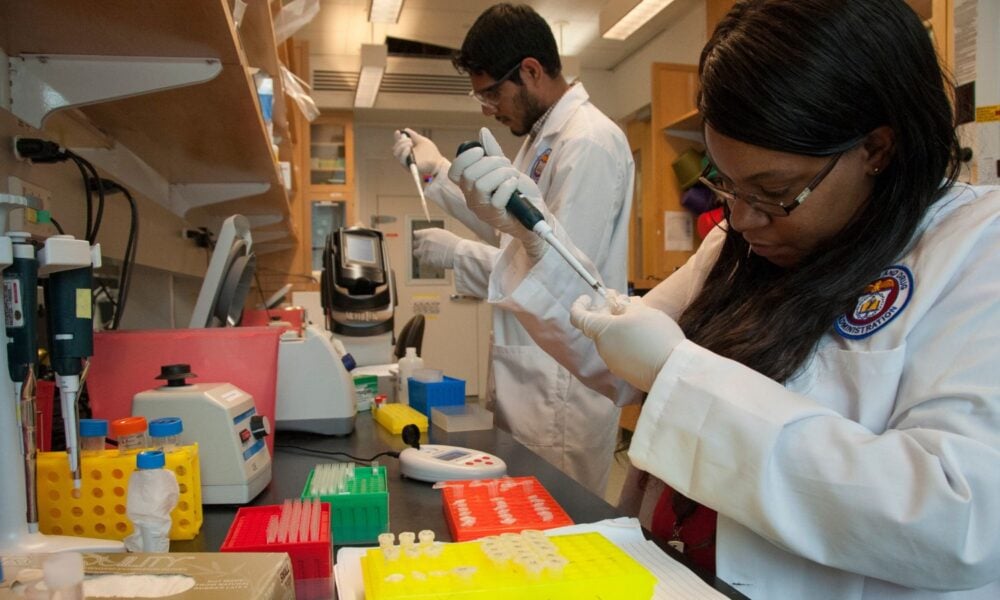At the Union of Concerned Scientists, one of our top priorities is reminding the public—and at times, the government—that a robust workforce of federal scientists is necessary for representing the interests of ordinary people. Federal scientists provide the rigorous, independent evidence and data that are essential ingredients for policy, laws, and practices that truly serve the public, not special interests. This includes science and analysis to reduce pollutants in our air and water, and to make our food and medicines safer and more available. Federal scientific research has also led to valuable inventions including wireless headsets, memory foam, and the Jaws of Life.
We depend on federal science, and federal science depends on an empowered, capable, diverse workforce.
Unfortunately, because of a combination of factors—including a brain drain during the Trump administration, decades of leaders and pundits devaluing public service, a legacy of white supremacy in STEM fields, and the slow pace of change in the federal government—our federal scientific enterprise lags behind where it could be.
The Union of Concerned Scientists’ vision is of a federal scientific workforce that reflects the population it serves in its diversity, especially among its leadership; that adheres to strong scientific integrity policies to carry out agency missions; and is empowered to produce and use independent science to create policies that keep us all safe.
In our newest report, Strengthening and Diversifying the Federal STEM Workforce, my colleagues held a roundtable panel with a set of distinguished experts to identify the challenges of staffing and morale facing federal agencies with scientific missions, and collaborated with the panelists to examine existing research and offer issue-specific recommendations to address these challenges.
This issue carries special resonance for me, as my grandfather, Edward C.T. Chao, was a career federal scientist who served the US Army and then the government for 45 years. As a principal investigator for NASA on the Apollo project, and as a lead scientist in the US Geological Survey, his research and discoveries in minerology created billions of dollars’ worth of industry in the US and beyond. Federal service was, unfortunately, also where he experienced persistent racism and xenophobia as a Chinese scientist.
A lot has changed since my Y-Kung’s time. But there’s still an urgent need for federal agencies to successfully attract, welcome, promote, and retain scientists with marginalized identities. For example, our analysis of the latest demographic data on federal scientists available through the Office of Personnel Management shows that racial and ethnic inequities persist at federal agencies, confirming what we heard from federal scientists themselves in our latest survey. While hiring has surged and diversity at certain agencies has increased, there is room for improvement.

Diversity matters in federal science—and in STEM generally
At UCS, a science-based organization, we know from experience and evidence that we must nurture a diverse workforce, and place equity and inclusion at the center of our internal practices and external work. We know this is the only way we can tap the vital experience and expertise that lives inside the communities most affected by the issues we work on, so that we can deliver the best science, and mobilize the broadest base of support required to achieve the speed, scope, and scale necessary to stem climate catastrophe, strengthen democracy, and avoid nuclear war. We don’t get it right all the time, but we are committed to this journey.
Centering diversity within science is clearly the right thing to do, which is why it sometimes feels unnecessary to me to justify these efforts with science. But of course, multiple studies indicate that diverse teams perform better and make more effective decisions. Evidence also suggests that diverse groups make fewer factual errors, process information more carefully, are less likely to succumb to groupthink, and are more likely to suggest innovative and creative solutions. One study found that public health agencies employing a diverse workforce yield more innovative public health approaches and develop a greater variety of solutions to help address health disparities.
Given the critical role played by the expert scientists who work in agencies like the EPA, CDC, and NOAA, who inform government decisions that impact our health and safety, we can all benefit from a stronger and more diverse federal STEM workforce. Scientific agencies that ignore this imperative are not only at risk of entrenching and exacerbating existing inequities, but are also at risk of cultivating a workforce that is less capable of adapting to new opportunities and challenges.
In many ways, the shortcomings of federal STEM workplaces mirror STEM workplaces in academia and industry more generally. My colleagues describe the current environment for Black, Indigenous and people of color in STEM with the following unhappy statistics, compiled from the linked sources:
- From 2011 to 2021, individuals identifying as Black have seen their representation increase in the STEM workforce from 7 percent in 2011 to 9 percent in 2021—but Black people represent 13.6 percent of the US population.
- The representation of people identifying as American Indian or Alaska Native—racial categories that together make up 1.3 percent of the US population—increased by only 0.2 percent over this same period, from 0.4 percent in 2011 to 0.6 percent in 2021.
- Black and Latine adults are less likely to earn degrees in STEM than in other fields, and they continue to make up a lower share of STEM graduates relative to their share of the adult population.
- Women make up half of those employed in STEM jobs, but representation varies widely across different STEM professions, with women representing three-quarters of health-related jobs and only one-quarter or less of computing and engineering jobs.
As a woman of color who pursued a STEM education, I can affirm that the unwelcoming environment I encountered turned me away from the field of medicine. I’d dreamed of applying my love of science to become a doctor—but my first college, which had only recently begun to accept women, still treated me (and all the other female students) like we couldn’t do the work. The struggle wore me down in my pursuit of medicine and I left the program and the school to pursue a degree in social sciences 3,000 miles away. I have no regrets for the way my life has turned out since then, but I do regret that STEM fields are still unwelcoming for students with marginalized identities.
Recommendations for federal agencies
While we at UCS have no illusions about the complexity of tackling discrimination and intolerance within STEM fields, or of encouraging diverse and inclusive workplaces at federal agencies with scientific missions, our authors do provide more than a dozen thoughtful, specific, evidence-based recommendations for both. If you’re a federal scientist in any position, I hope you’ll give the full report a careful read.
One recommendation I found deeply resonant was the team’s suggestion to create formal mentoring programs within federal workplaces to improve retention and cultivate welcoming and inclusive work environments, wherein early-career scientists with marginalized identities can rely on advice and wisdom from people with similar life experiences. (The report authors go on to provide details of how such mentorship programs should be established, including providing diversity, equity, inclusion, and accessibility-sensitive training to all potential mentors.) In my own life and career, I’ve benefited so much from seeking out mentors and allies who have been willing to take me under their wing and offer advice; I’m sure I would have benefited even more from formal or structured mentorship programs in my various educational and work settings. To repay the favor, I’m passionate about providing the same opportunities—mentoring, building networks, providing advice, and above all, listening—to others.
My colleagues confirm the value of mentoring programs, writing:
“For BIPOC STEM professionals, a mentoring relationship can facilitate building a scientific identity, increase socialization and integration into the community, reduce implicit biases, and create a sense of belonging. Creating a positive, welcoming environment through a strong mentoring relationship will contribute not only to greater job satisfaction but to the individual’s feeling of success in their work environment.”
Beyond mentorship programs for retention, my colleagues also provide detailed suggestions for the following categories of recommendations (and many more):
- Cultivate a united organizational culture and sense of belonging
- Attract new talent into the federal scientific workforce
- Address the needs of the changing workplace
- Reevaluate evaluations, compensation, and salaries
- Build diversity, equity, inclusion, and accessibility principles into agency science
Their full recommendations can be found in chapter six of the report.
Moving toward a culture of inclusion
As the population of our country becomes more diverse, we desperately need matching representation in the agencies that make decisions about what we eat, the medicines we take, the air we breathe, the water we drink, and the thousands of products, processes, and interactions that make up our lives. Failure to diversify federal scientific workplaces will only further perpetuate cultural biases, exclude talented scientists, and ensure an inequitable status quo.
I look forward to the day when the intolerance and discrimination that affected my grandfather’s career and my own—and that continue to drive away scientists with marginalized identities—are no longer seen as the necessary price to pay for careers in STEM. Much more work needs to be done, but the federal government can lead the way towards real inclusion in STEM education and workplaces.

